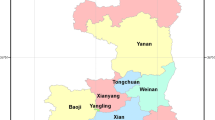Abstract
The present study develops a projection pursuit dynamic cluster (PPDC) model by combining dynamic cluster with projection pursuit to solve the problem of regional partition of water resources in China. The procedures of the PPDC model are described as follows. Firstly, a multi-factor cluster problem can be converted into a single-factor (projected characteristic value) cluster problem according to linear projection. Secondly, a new projection index on the basis of dynamic cluster rule is set up in the PPDC model, which successfully avoids the problem of parameter calibration and makes objective cluster results. Thirdly, genetic algorithm (GA) is applied to optimize projection direction of the PPDC model. Finally, the developed PPDC model is used in a case study of regional partition of water resources in China to evaluate its application. The cluster results of the PPDC model agree well with the actual regional partition of water resources in China, indicating that the PPDC model is a powerful tool in multi-factor cluster analyses and could be a new method for regional partition of water resources.
Similar content being viewed by others
References
Chau KW (2002) Calibration of flow and water quality modeling using genetic algorithm. Lecture Notes in Artificial Intelligence 2557:720
Chau KW (2004) A two-stage dynamic model on allocation of construction facilities with genetic algorithm. Autom Constr 13(4):481–490
Chau KW, Albermani F (2003) Knowledge-based system on optimum design of liquid retaining structures with genetic algorithms. J Struct Eng, ASCE 129(10):1312–1321
Cheng CT, Ou CP, Chau KW (2002) Combining a fuzzy optimal model with a genetic algorithm to solve multiobjective rainfall–runoff model calibration. J Hydrol 268(1–4):72–86
Cheng CT, Wu XY, Chau KW (2005) Multiple criteria rainfall–runoff model calibration using a parallel genetic algorithm in a cluster of computer. Hydrol Sci J 50(6):1069–1087
Cheng CT, Zhao MY, Chau KW, Wu XY (2006) Using genetic algorithm and TOPSIS for Xinanjiang model calibration with a single procedure. J Hydrol 316(1–4):129–140
Cheng CT, Wang WC, Xu DM, Chau KW (2007) Optimizing hydropower reservoir operation using hybrid genetic algorithm and chaos. Water Resources Management. DOI 10.1007/s11269-007-9200-1
Cui HJ (1997) The laws of the iterated logarithm for two kinds of PP statistics. Stat Probab Lett 32(3):235–243
Dong SH (2007) Genetic algorithm based parameter estimation of Nash model. Water Resources Management. DOI 10.1007/s11269-007-9208-6
Friedman JH (1987) Exploratory projection pursuit. J Am Stat Assoc 82:249–266
Friedman JH, Tukey JW (1974) A projection pursuit algorithm for exploratory data analysis. IEEE Trans Comput C-23:881–890
Friedman JH, Stuetzle W (1981) Projection pursuit regression. J Am Stat Assoc 76:817–823
Friedman JH, Stuetzle W, Schroeder A (1984) Projection pursuit density estimation. J Am Stat Assoc 79:599–608
Hall P (1989) On polynomial-based projection indices for exploratory projection pursuit. Ann Stat 17(2):589–605
Har-even M, Brailovsky VL (1995) Probabilistic validation approach for clustering. Patter Recogn Lett 16(11):1189–1196
Holland JH (1975) Adaptation in natural and artificial system. University of Michigan Press, Ann Arbor, Michigan
Hwang JN, Lay SR, Maechler M, Martin RD, Schimert J (1994) Regression modeling in back-propagation and projection pursuit learning. IEEE Trans Neural Netw 5(3):342–353
Lin W, Tian Z, He F (2003) On improving unsupervised restoration of image with PPWLN. Journal of Northwestern Polytechnical University 21(3):344–347 (in Chinese)
Liu CM, Fu GB (2000) Water world today. Tsinghua University Press, Beijing (in Chinese)
Ren RE, Wang HW (1999) Multi-dimensional statistics data analysis – theory, method and practice. National Defence Industry Press, Beijing (in Chinese)
Wang SJ, Zhang XL, Ding J et al (2002) Projection pursuit cluster model and its application. Journal of Yangtze River Scientific Research Institute 19(6):53–55 (in Chinese)
Wang SJ, Zhang XL, Yang ZF, Ding J, Shen ZY (2006) Projection pursuit cluster model based on genetic algorithm and its application in Karstic water pollution evaluation. Int J Environ Pollut 28(3–4):253–260
Yu B, Cheng CT, Yang ZZ, Chau KW (2005) Application of PGA on optimization of distribution of shopping centers. Lecture Notes in Artificial Intelligence 3673:576–586
Zhang XL, Ding J, Li ZY, Jin JL (2000) Application of new projection pursuit algorithm in assessing water quality. China Environ Sci 20(2):187–189 (in Chinese)
Author information
Authors and Affiliations
Corresponding author
Rights and permissions
About this article
Cite this article
Wang, SJ., Ni, CJ. Application of Projection Pursuit Dynamic Cluster Model in Regional Partition of Water Resources in China. Water Resour Manage 22, 1421–1429 (2008). https://doi.org/10.1007/s11269-007-9234-4
Received:
Accepted:
Published:
Issue Date:
DOI: https://doi.org/10.1007/s11269-007-9234-4




